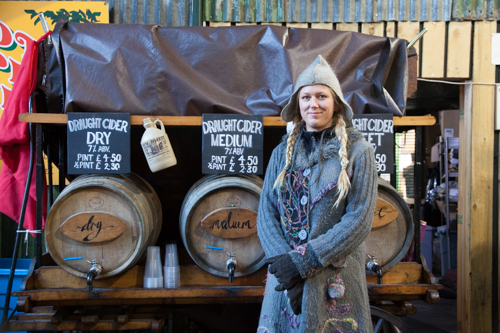St Lucia's Day
 Wednesday, December 13, 2017 at 6:02AM
Wednesday, December 13, 2017 at 6:02AM 
This article is part of a 3 part series currently featuring on the Borough Market website which focuses on a few religious festivals celebrated in December, other than Christmas, and the foods associated with them. I interviewed trader Erica Fransson, who grew up in the South-East of Sweden near Kalmar, to get some local insight on the festivities.
Food is the most basic human necessity; we depend on it for our survival. Food can also build and sustain communities and identity. When we cook, taste and eat food together we create shared memories and powerful social bonds. It is hardly surprising then that food is so often used in religion as a symbol not only of the divine, but of life itself.
On St Lucia’s Day (13th December) in Sweden, food is one of a number of material symbols used to tell the story of Lucia, a young Christian girl who was martyred in 304. “Sankta Lucia used to go in the catacombs in Italy and give food to Christians who were hiding there,” Erica Fransson, trader at The Cider House, tells me. The story goes that she used to wear a wreath or crown on her head with candles to light her way and to free her hands to carry the food.
The most common festive treat eaten on St Lucia’s Day in Sweden is lussekatter, saffron buns that usually come in an ‘S’ shape decorated with raisins. You can also “put a few of those swirls together so it looks like a crown” Erica tells me. This saffron bread, plaited and curled round into the shape of a crown and decorated with candles, is often the centrepiece of St Lucia celebrations across Sweden.

Erica explains that each town or school chooses a young girl to play St Lucia in a local procession. “She’s got a crown made with leaves and candles. Around her waist she has a red ribbon that hangs down the left side, I think, because that is where Sankta Lucia was stabbed with a sword by the Romans so it signifies the blood she shed.”
As a child, Erica would be woken up by her parents at 5.30am to drink coffee and eat lussekatter and pepparkakor (gingerbread cookies) before watching the 6am broadcast of the national St Lucia, the girl chosen to lead the national procession.
There would also be a St Lucia procession at her school – girls with glitter in their hair holding candles would follow their chosen St Lucia to elderly care homes and the local church. They would sing Christmas carols and Christian songs “and afterwards there would be tea and coffee and more saffron buns and gingerbread cookies.” Erica was always in the procession and when she was 15 she was picked to play St Lucia.
Lucia means ‘light’ and this is also an important part of the festival in Sweden. As with Christmas, “there was a pagan celebration before the traditional Christian one,” Erica explains. “In the old calendar, St Lucia’s Day used to be the winter solstice, the darkest night of the year. People thought there were lots of bad spirits out this night, so they put lots of candles out to keep them away and they were awake all night eating and drinking. The Christians basically took over and adopted that tradition.”
Today, Erica finds it hard to get back to her family for 13th December, as she is always busy working at the market, but she still likes to celebrate St Lucia’s Day. “The Swedish Church in England has got Sankta Lucia celebrations in St Paul’s Cathedral and Southwark Cathedral.” She went last year, but if she can’t make it, she still gets up very early to watch the broadcast online in the morning and “when I have time, I bake the saffron buns as well,” she says. “It’s one of those things that if you like traditions, you have to do every year.

See the recipe for St. Lucia's Crown here or on the Borough Market website.
 Vix |
Vix |  Post a Comment |
Post a Comment |  Borough Market,
Borough Market,  Sweden,
Sweden,  festive,
festive,  symbolism in
symbolism in  Religion
Religion 
Reader Comments